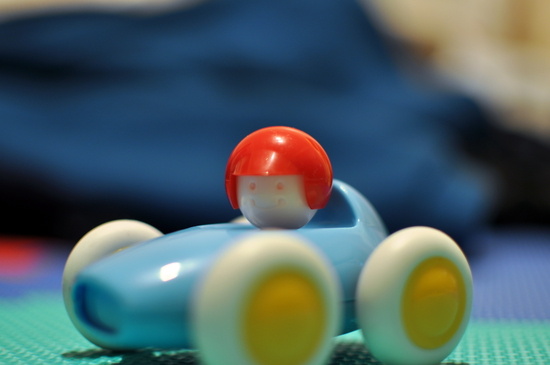Not really. This is nothing like a rigorous comparison of anything to anything. That would be work and this is for fun.
The other day I posted the first photo I took with my Nikon D90. Never having had a dSLR before, I’ve been impressed with its capabilities.
I wasn’t sure how much of my impression was because it’s so neat to hold and use, and because I’m invested (financially and emotionally) in the idea that it should take better pictures than my old compact cameras, a 2006-era Canon Powershot A700, and a 2008-era Panasonic Lumix DMC-LX3. To be sure, the D90 focuses faster, has less high-ISO noise, and ratchets happily through several shots in a burst, vastly improving my chances of a good shot of a moving subject. It is, of course, gigantic by comparison.
Here’s another look at my D90’s first shot, using a 35mm prime lens at f1.8. I would tweak the composition if I were doing it again. I’m still pleased with it, in that I like the subject and it’s not badly out of focus. I went straight for the shallowest depth of field I could get with my new toy.
Because the subject of the photo is good at holding still (when G is asleep), it’s a good candidate for a gentle comparison with cameras that don’t focus as fast and need more light. I decided to take some shots of it with the A700 and the LX3, to see more clearly what’s different about using the different cameras for the (admittedly narrow) category of close-ups of small, motionless toy cars.
I think it’s fair to say these cameras both stretch the designation “point-and-shoot.” Both have manual modes available, allowing aperture, shutter speed, and focus to be set explicitly (although the manual focus is done with a button or joystick and has to be assessed on the digital display, all of which is highly irritating).
The LX3 has a peculiarly wide-angled bias, sacrificing zoom for light-collecting efficiency, and, well, wide angle. My A700, with its “6x” zoom, covers the other extreme reasonably well, so the two complement each other well.
Here’s a try for shallow depth of field with the LX3, at f2.0, its max aperture:
Zooming out all the way lets me access this wide aperture setting, as well as letting me get in close, which increases the relative distances between things I want in focus and things I don’t.
Don’t mind the background. One of these days I’ll develop an eye for composition.
Here’s another LX3 shot, zoomed in a bit and taken at f2.6. Sometimes you don’t even need the shallowest depth of field you can get. This shot has less of the wide-angle distortion evident in the preceding photo. On an unrelated topic, it’s nice to keep the background objects under control a little!
Moving on to the ol’ A700:
That is the biggest aperture available on that camera: “f2.8.” There’s an unfortunate coincidence of a light-reflecting fold in the blanket in the background that makes it look as if the blown-out reflection on the helmet is accompanied by a fuzzy halo.
Try backing up and zooming in, with a resulting narrowing of the aperture to f4.8:
Again, sometimes a bit more depth of field is a nice thing. I put those dust fibres on the toy just to test the crispness of focus.
The other thing about the A700 is that it’s small and easy to grip. This means that on cycling trips I didn’t miss shots like this. I wouldn’t have the same confidence with the LX3, with its stingy little grip-like protrusion, and with the D90, well, ferget it. If you have to stop riding to take the photo, you’ve already missed it. With a nice SLR, you could get some different awesome photos, but stopping every time I see a photo I want to take would be excruciating for F. We already practice “just-in-time” (or the closely-related but less hyped “too-late”) bike touring, as regards the opening hours of food stores, restaurants, and campsite offices.
To be honest, I like all of these shots. That happy little plastic head on wheels just makes me feel like smiling.
Finally: the D90 was cheating in that first photo. Here’s an attempt to get in close with the kit lens (18-105mm f3.5-5.6):
Here I had to zoom in to get the car to fill up very much of the frame, as the lens can’t focus from very close to the subject. The widest aperture available at this zoom was f5.6.
With the kit lens, the D90 really isn’t as appropriate for this subject as my all-rounder compact cameras. Which is fine, because that’s the point of having interchangeable lenses. Clearly the f1.8, 35mm lens I took that first photo with gives a huge advantage if you’re after “bokeh” (someday I will probably not feel that this is an acutely pretentious term, but for now I can’t use it straight, so on go the quotation marks). It is sobering to realize that this lens on its own cost, if I remember correctly, about 80% of what I paid for the entire Powershot A700 camera in 2006.






